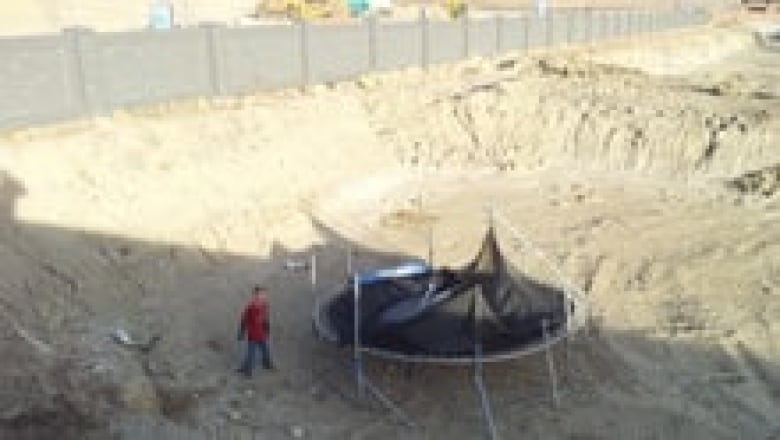Calgary storm aftermath causes commuter headaches
LRT service resumes, but Calgary Transit advising commuters to avoid 7th Ave. corridor
Commuters in Calgary struggled to get to work downtown on Monday after a severe windstorm swept through southern Alberta Sunday, prompting officials to shut the city’s core to traffic as glass and debris rained down on the streets.
Most of the glass debris has been cleaned up. LRT service resumed at 4 p.m. Monday, but long delays remained and Calgary Transit advised supper-time commuters to stay away from the 7th Ave. corridor. The 3rd St. LRT station remains closed.
A strong low-pressure system combined with a Chinook blowing east from the mountains produced sustained winds of 77 kilometres per hour, with gusts reaching 144 km/h in Claresholm, equivalent to a Category 1 hurricane, said CBC meteorologist Johanna Wagstaffe.

The downtown core was reopened to all vehicle and transit traffic, except LRT service, by 4:30 a.m. MT. But several streets remained closed:
- No vehicle and pedestrian traffic on 8th Street S.W. between 6th and 7th avenues S.W.
- No vehicle and pedestrian traffic on 7th Avenue S.W. between 8th and 10th streets S.W.
- Vehicle access, but no pedestrian traffic on 2nd Street between 8th Ave. And 6th Ave. S.W.
- No pedestrian traffic on 7th Avenue between 2nd and 3rd streets S.W.
City officials are still working on a damage estimate from the storm, but Mayor Naheed Nenshi said the province and the federal government will likely help pay for it.
"The province does have a system to help reimburse us with some of the costs. I also received a letter last night from the political minister for Calgary in the federal government, offering any assistance the federal government can provide," he said.
Nenshi said more than 100 city workers spent all night helping to ensure the downtown area was safe by Monday morning.
About 40 shuttle buses brought commuters into the core while Calgary Transit worked to restore C-Train service downtown.
Chinooks
- Chinooks occur when dry west winds, warmed by compression, flow over the mountain ranges and down the eastern slopes toward Calgary.
- The winds can raise winter temperatures from as low as −20 C to as high as 20 C in just a few hours.
- Chinooks blowing off the Rockies regularly reach speeds of 65- to 95 km/h with gusts topping 160 km/h.
- A telltale sign of a chinook is the often beautiful arch — a band of stationary stratus clouds caused by air rippling over the mountains.
But Bruce Burrell, director of emergency management, said electricity to the LRT line must remain off until officials are certain that a construction crane over Seventh Avenue is secure.
Duty Insp. Keith Cain of the Calgary police said windows at TD Square downtown were blown out, roofing material and debris flew off downtown buildings and a roof was ripped off at a home in the 100 block of Slopes Grove S.W.
One firefighter said debris from one building was breaking off and shattering glass in a neighbouring building. The firefighter said it was "raining glass" in the area.
Burrell said the winds were even more powerful at higher altitude.
"So even though the wind is currently 50 km/h on the ground, at higher elevations — at the height of the Bow tower — those winds are 149 km/h.
"So it's those winds that are causing damage to higher structures in the downtown core, and that's why we're seeing glass and debris come off those structures."

One firefighter suffered minor injuries from falling glass, Burrell said. No other injuries were reported. Fire officials said the entire department was out on city streets.
All pathways in the west half of Fish Creek Provincial Park in south Calgary were closed after dozens of trees were damaged in the storm, the province said in a written release.
"It's a lot more severe out in the country where there isn't anything to block the winds when it's coming across the fields," said Jillian Millar, who drove south from Calgary on Sunday afternoon with her husband to pick up their daughter from a party. "We didn't realize it was as bad as it was when we left the house."
Millar said farm animals were seeking shelter behind whatever they could find. She said she saw horses huddled beside a parked school bus.

At Pincher Creek, in the southwestern corner of the province, winds reached 130 km/h by midday Sunday, Environment Canada reported.
High River activated its Emergency Operations Centre at 2 p.m. A firewall at Sunrise Terrace Apartments separated from the building, leading to an evacuation.
RCMP issued a travel advisory for motorists travelling from Calgary south to the American border.
Officials warned that semi-trailers, especially if they are empty or carrying a light load, should avoid travel during high winds. A semi was blown over by winds between Crossfield and Bowden.
Raging grass fire
In Lethbridge County, southeast of Calgary, a grass fire fuelled by the high winds forced at least 125 people from their homes just west of town.
Two homes on the Blood Reserve were lost to flames.

RCMP officers went door-to-door telling people they had to leave their homes, and more than 100 people followed their instructions. Others were advised to stay away from affected areas and remain inside with their doors and windows closed.
Winds blew the flames to the outskirts of Lethbridge, but the winds abated late Sunday evening and firefighters were able to get the blaze under control.
Lethbridge County is in a state of emergency that remained in effect Monday morning as firefighters dealt with remaining flames in coulees and concerns over downed power lines.
With files from The Canadian Press